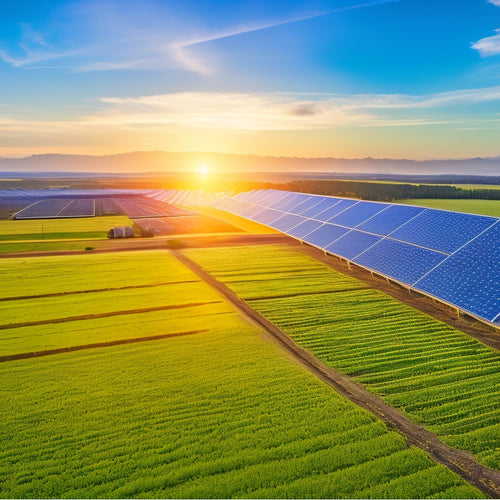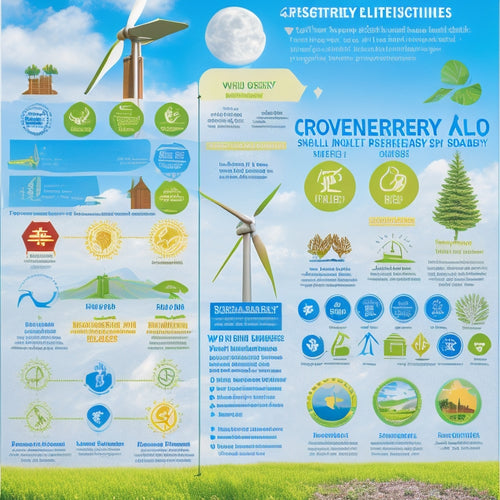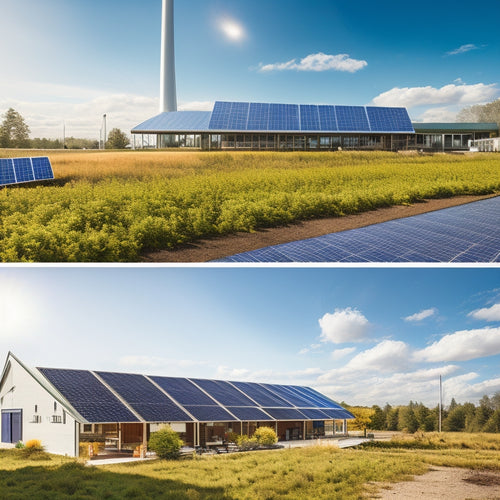
Calculate Your Solar ROI With These 10 Essential Tips
Share
To calculate your solar ROI, start by determining your energy consumption patterns and evaluating your current energy costs. Evaluate the ideal system size and configuration for your property, considering factors like roof size and shading elements. Research local incentives and rebates that can reduce your upfront costs. Calculate the total installation costs, including material and labor expenses, and weigh your finance options carefully. Don't forget to evaluate maintenance requirements and consider energy storage options. Finally, guarantee compliance with local building codes. By following these essential tips, you'll gain a clearer understanding of your solar investment's potential returns - and potentially uncover even more opportunities to maximize your savings.
Key Takeaways
• Assess energy consumption patterns, roof size, and orientation to determine the ideal solar panel system configuration for maximum ROI.
• Calculate current energy costs, identify energy-wasting areas, and analyze monthly consumption data to understand financial impact.
• Factor in local incentives, state rebates, and government grants to increase ROI and reduce upfront installation costs.
• Consider energy storage integration, battery type, and size to enhance system performance, value, and energy security.
• Account for material expenses, labor costs, and permitting fees to get an accurate breakdown of installation costs and ROI.
Determine Your Energy Consumption
To calculate your solar ROI, you'll need to determine how much energy your home or business consumes. Start by reviewing your past utility bills to get an accurate picture of your energy usage patterns. This step is important in understanding your energy consumption habits.
Conducting an energy audit will help you identify areas of inefficiency and opportunities for improvement. By analyzing your utility bills, you'll be able to pinpoint the times of day and year when your energy usage peaks. This information will enable you to determine the best size and configuration of your solar panel system.
A thorough energy audit will provide valuable insights, allowing you to make informed decisions about your solar investment and maximize your ROI.
Assess Current Energy Costs
By examining your past utility bills, you've gathered a thorough understanding of your energy consumption patterns, and now it's crucial to assess the financial impact of these energy habits by calculating your current energy costs. This will help you understand the scope of your energy expenses and identify areas for improvement. Conducting an energy audit can also help you pinpoint energy-wasting areas in your home or business.
| Month | Energy Consumption (kWh) | Cost ($) |
|---|---|---|
| January | 800 | 120 |
| February | 750 | 110 |
| March | 850 | 130 |
Evaluate System Size Requirements
As you evaluate system size requirements, you'll need to assess your energy consumption patterns to determine the ideal system size for your needs.
You'll also need to take into account the size and orientation of your roof to guarantee a suitable installation area.
Additionally, you'll want to factor in any shading factors, such as trees or neighboring buildings, that could impact your system's performance.
Assess Energy Consumption
You'll need to accurately assess your energy consumption to determine the ideal system size for your solar panel installation. This involves reviewing your past utility bills to understand your energy usage patterns. Conducting an energy audit can also help identify areas of energy inefficiency in your home.
| Energy Usage Patterns | Average Daily Usage (kWh) |
| Peak Summer | 35-40 kWh |
| Winter | 20-25 kWh |
| Average | 28-32 kWh |
Determine Roof Size
Your roof's size and condition will have a significant impact on determining the ideal system size for your solar panel installation. It's important to evaluate the available space carefully. Consider your roof's architecture, including its shape, slope, and orientation. These factors will influence the number of panels you can fit and their best placement.
Additionally, assess your roof's materials, as certain types may require special installation considerations. For instance, clay or slate tiles may require additional structural support, while metal roofs may need specific mounting systems. By carefully evaluating these factors, you'll be able to determine the maximum system size your roof can accommodate, ensuring an effective solar panel installation.
Consider Shading Factors
With your roof's size and condition assessed, you'll need to evaluate the impact of shading on your solar panel system, as obstructions like trees, buildings, and chimneys can greatly reduce energy production. Shading factors can vary depending on the time of day, season, and location. To accurately assess shading, consider the following:
| Shading Factor | Description | Impact on Energy Production |
|---|---|---|
| Tree Canopy | Branches and leaves block sunlight | 10-20% reduction |
| Building Orientation | Angle and direction of solar panels | 5-15% reduction |
| Chimneys and Vents | Obstructions cast shadows on panels | 5-10% reduction |
Consider Local Incentives Available
What local incentives are available to boost your solar investment's ROI?
As you calculate your solar ROI, don't forget to factor in local incentives that can greatly impact your returns.
You may be eligible for state rebates, which can offer a fixed amount per watt of installed solar capacity. Additionally, government grants can provide a percentage of the total project cost.
These incentives can substantially reduce your upfront costs, increasing your ROI. Research the incentives available in your area and factor them into your calculations.
You can check with your local government or utility company to see what incentives are available.
Calculate System Installation Costs
Determining the total installation cost of your solar panel system involves tallying up the expenses of equipment, labor, and permits. To get an accurate calculation, you'll need to break down these costs into specific categories.
Here are the key components to take into account:
-
Material Expenses: This includes the cost of solar panels, inverters, mounting hardware, and other equipment.
-
Labor Costs: This covers the cost of hiring professionals to install your system, including their hourly rates and any additional fees.
-
Permitting and Inspection Fees: These are the costs associated with obtaining necessary permits and passing inspections.
Analyze Panel Efficiency Ratings
You'll want to examine the efficiency ratings of your solar panels to maximize energy production, as they greatly impact the overall performance of your system.
High-efficiency panels can generate more power per hour of sunlight, resulting in higher returns on investment.
When evaluating panel quality, look for efficiency metrics such as peak sun hours and temperature coefficients. These metrics will give you a better understanding of how well your panels will perform in different conditions.
Be wary of low-efficiency panels that may seem cheaper upfront but will ultimately cost you more in the long run.
Weigh Finance Options Carefully
When weighing finance options for your solar panel system, you'll want to carefully compare loan options to find the best fit for your budget.
You'll also need to evaluate the incentives available, such as federal and state tax credits, to maximize your return on investment.
Compare Loan Options
By evaluating financing options carefully, you can greatly impact the overall cost of your solar panel system and maximize your return on investment. To make an informed decision, consider the following key loan factors:
-
Interest rate caps: Look for lenders that offer competitive interest rates with caps to guarantee your payments won't skyrocket.
-
Loan term flexibility: Choose a lender that offers flexible loan terms, allowing you to adjust your payments to fit your budget.
-
Prepayment penalties: Check if the lender charges penalties for early repayment, which could affect your ROI.
Evaluate Incentives
In addition to financing options, federal and state governments offer various incentives that can greatly impact your solar ROI, and it's important to carefully consider these benefits.
You'll want to explore federal Tax Credits, which can cover up to 26% of your total system cost. Additionally, many states offer State Rebates, which can further reduce your upfront costs.
Be sure to research and understand the specific incentives available in your area, as they can vary greatly.
By taking advantage of these incentives, you can significantly enhance your solar ROI and accelerate your payback period.
Don't overlook these valuable benefits – carefully evaluate and incorporate them into your financial planning to maximize your solar investment.
Evaluate Maintenance Requirements
You'll need to factor in the maintenance requirements of your solar panel system to guarantee peak performance and maximize your return on investment. Regular maintenance guarantees your system operates at its best levels, reducing the risk of energy losses and costly repairs.
Consider the following maintenance requirements:
-
Scheduled servicing: Regular cleanings and inspections to prevent debris buildup and detect potential issues early.
-
Warranty coverage: Review your warranty terms to understand what's covered and for how long, ensuring you're protected against unexpected repair costs.
-
Component replacement: Plan for the replacement of inverters, batteries, or other components that may have a shorter lifespan than the rest of the system.
Consider Energy Storage Options
As you calculate your solar ROI, integrating energy storage options into your system can greatly enhance its overall performance and value, allowing you to store excess energy generated during the day for use during nighttime or power outages.
By incorporating a battery backup system, you'll enjoy greater energy security and independence from the grid. This means you'll have a reliable source of power during outages, and you can also reduce your reliance on non-renewable energy sources.
When evaluating energy storage options, consider factors such as the type and size of batteries, charging and discharging rates, and compatibility with your existing solar panel system. By doing so, you'll be able to accurately calculate the ROI of your solar investment and make informed decisions about your energy storage needs.
Review Local Building Codes
Before installing your solar panel system, verify that it meets local building codes and regulations to avoid costly rework or even system removal. You'll want to guarantee compliance with zoning regulations, permit requirements, and other local ordinances.
Here are some key considerations:
-
Zoning regulations: Check if there are any restrictions on solar panel installation in your area, such as height or setback requirements.
-
Permit requirements: Determine what permits are needed and obtain them before starting the installation process.
-
Electrical and fire codes: Verify that your system meets local electrical and fire codes to avoid any potential safety hazards.
Frequently Asked Questions
Can I Install Solar Panels on a Rented Property?
You'll need to review your rental agreements to determine if installing solar panels is allowed; obtain written permission from your property owners, and secure their consent before making any installations.
How Long Does a Typical Solar Panel Warranty Last?
"A million things can go wrong, but a typical solar panel warranty lasts around 25 years, covering manufacturer liability. You can breathe easy, as many manufacturers offer warranty extensions, giving you peace of mind for decades to come."
Do Solar Panels Work During Power Outages?
You're wondering if solar panels work during power outages? Typically, they don't, since they're grid-tied and shut down for safety reasons. However, with grid independence and an emergency backup system, you can maintain power during outages.
Can I Add More Panels to My Existing System Later?
You can easily expand your existing solar system, just like the Smiths who upgraded from 5 kW to 10 kW to power their new electric vehicle. You can undertake a system expansion or energy upgrade at any time, as needed.
Are Solar Panels Affected by Pollution or Dirt Buildup?
You'll find that dust accumulation on your solar panels can reduce energy output, but don't worry, you can maintain efficiency with regular cleaning methods, such as gentle water rinses or specialized cleaning solutions.
Related Posts
-

Solar Power for Reducing Carbon Footprint
Solar power is an effective strategy for reducing your carbon footprint. By adopting solar energy, you can cut greenh...
-

Renewable Energy Certifications for Businesses
Renewable energy certifications are essential for your business, showcasing your commitment to sustainability and enh...
-

Off-Grid Solar Solutions for Eco-Conscious Businesses
Off-grid solar solutions offer you a path to both sustainability and substantial cost savings. By adopting these syst...


